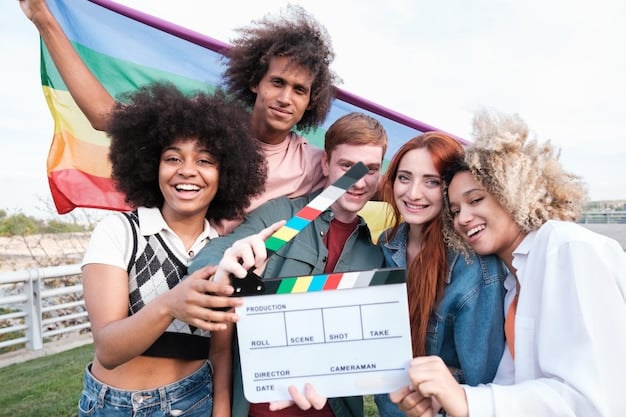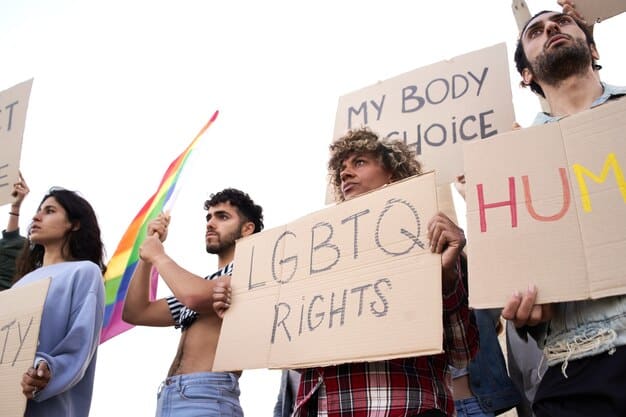Gen Z’s LGBTQ+ Rights Advocacy: SCOTUS Impact 2025

Gen Z’s unwavering advocacy for LGBTQ+ rights, rooted in principles of inclusivity and equality, faces a critical juncture as 2025 approaches; the Supreme Court’s decisions on same-sex marriage could fundamentally reshape their engagement and the broader sociopolitical landscape, influencing legislative battles and grassroots movements for years to come.
The evolving landscape of social rights, particularly for the LGBTQ+ community, is a subject of constant deliberation and activism. A pivotal force in this ongoing conversation is Generation Z, a cohort known for its fervent commitment to social justice and inclusivity. This article delves into Gen Z’s Advocacy for LGBTQ+ Rights: How Will the Supreme Court’s Decisions on Same-Sex Marriage Impact Their Social and Political Landscape in 2025? We will explore the historical context, Gen Z’s unique activist approach, potential legal shifts, and the profound implications these judicial outcomes could have on their future engagement in the United States.
Gen Z’s Role in Modern LGBTQ+ Advocacy
Gen Z, born roughly between 1997 and 2012, is often characterized as the most diverse and socially conscious generation to date. Their digital native upbringing has provided them with unprecedented access to information and platforms for collective action, making their advocacy both visible and highly effective. This generation approaches LGBTQ+ rights not as a peripheral issue, but as a fundamental aspect of human rights and social justice.
Their engagement goes beyond traditional forms of activism. While they participate in protests and rallies, their strength lies in their strategic use of social media, online petitions, and digital campaigns to raise awareness, mobilize support, and pressure institutions. For Gen Z, LGBTQ+ issues are deeply personal, encompassing identity, mental health, and the right to live authentically without discrimination. They are less focused on traditional political party lines and more on specific policy outcomes that align with their values of equity and inclusion. This pragmatic approach highlights a generational shift in how social change is pursued.
Digital Native Activism and Its Reach
Gen Z’s fluency with digital platforms allows them to disseminate information rapidly, react to legislative changes in real-time, and foster a sense of community among geographically dispersed individuals. They leverage platforms like TikTok, Instagram, and Twitter to share personal stories, educate peers, and organize grassroots movements. This digital prowess amplifies their voice, enabling them to reach wider audiences than previous generations could have imagined.
* Information Dissemination: Rapid sharing of news, legal updates, and personal narratives.
* Community Building: Creation of online safe spaces and support networks for LGBTQ+ youth and allies.
* Mobilization: Organizing digital protests, call-to-action campaigns, and virtual rallies.
* Direct Engagement: Tagging politicians, corporations, and public figures to demand accountability.
Intersectional Approach to Rights
Unlike some previous movements that might have focused on single issues, Gen Z’s advocacy is inherently intersectional. They understand that LGBTQ+ rights are inextricably linked to racial justice, gender equality, disability rights, and economic justice. This holistic view acknowledges that discrimination often compounds, affecting individuals with multiple marginalized identities. Their activism seeks to dismantle systemic inequalities at their roots, recognizing that true liberation requires a comprehensive approach. This broad perspective strengthens their movement, creating powerful coalitions across various social justice causes.
The unwavering support for the LGBTQ+ community by Gen Z is a defining characteristic of their activism. They champion not just the protection of existing rights, but also the expansion of protections and the recognition of diverse identities, pushing for a more inclusive society where all individuals are valued and respected. This generation’s commitment is a powerful force driving social progress forward.
Historical Context: Same-Sex Marriage and SCOTUS Precedents
Understanding the current landscape of same-sex marriage rights necessitates a look back at the Supreme Court’s pivotal rulings. The journey has been marked by significant legal battles and shifts in public opinion, culminating in nationwide recognition. These precedents form the bedrock on which future legal challenges and legislative efforts will be built.
Obergefell v. Hodges (2015)
The landmark decision in Obergefell v. Hodges fundamentally altered the legal standing of same-sex marriage in the United States. In this ruling, the Supreme Court held that the right to marry is guaranteed to same-sex couples by both the Due Process Clause and the Equal Protection Clause of the Fourteenth Amendment to the United States Constitution. This decision effectively legalized same-sex marriage nationwide, overturning state bans and requiring all states to license and recognize same-sex marriages.
The ruling was a culmination of decades of advocacy and provided significant relief and joy to millions of Americans. It affirmed the dignity and equality of same-sex relationships under the law, ensuring that same-sex couples could enjoy the same legal benefits and protections as heterosexual couples. For many, it represented a significant step forward in the civil rights movement. However, the legal landscape is rarely static, and subsequent challenges have emerged.
The Defense of Marriage Act (DOMA) and Its Repeal
Prior to Obergefell, the federal government’s stance on marriage was enshrined in the 1996 Defense of Marriage Act (DOMA). DOMA defined marriage for federal purposes as a legal union exclusively between one man and one woman, and allowed states to refuse to recognize same-sex marriages performed in other states. This act created a complex and discriminatory patchwork of laws across the country.
The unconstitutional aspects of DOMA were gradually dismantled by Supreme Court rulings. In 2013, United States v. Windsor struck down Section 3 of DOMA, which denied federal benefits to legally married same-sex couples. More recently, in 2022, the Respect for Marriage Act (RMA) was passed by Congress and signed into law. The RMA formally repealed DOMA, enshrined federal protections for same-sex and interracial marriages, and requires states to recognize valid marriages performed in other states. This legislative action was largely a response to concerns following the overturning of Roe v. Wade, which raised questions about the stability of other implied rights, including marriage equality.
The passage of RMA provided an additional layer of security for same-sex marriage, moving it from solely a judicial protection to a legislative one. However, the possibility of future legal challenges, particularly with a changing Supreme Court composition, remains a crucial concern for advocates.
Potential Supreme Court Challenges in 2025
As we look towards 2025, the potential for Supreme Court decisions to impact LGBTQ+ rights, particularly same-sex marriage, remains a significant concern for Gen Z and the broader community. The shifting ideological balance of the Court, coupled with the nature of some recent rulings, creates an environment where established precedents could face renewed scrutiny.
Rhetoric and Judicial Philosophy
The current composition of the Supreme Court has a pronounced conservative majority. This shift has led to an increased focus on originalism and textualism, judicial philosophies that interpret the Constitution based on its original meaning or the plain text, respectively. While these approaches have their proponents, they can sometimes lead to outcomes that diverge from evolving societal norms and established precedents based on broader interpretive frameworks.
Concerns among legal scholars and advocates intensified following the overturning of Roe v. Wade in 2022. Justice Clarence Thomas, in his concurring opinion in Dobbs v. Jackson Women’s Health Organization, explicitly called for the Court to revisit other substantive due process precedents, including Obergefell v. Hodges (same-sex marriage), Lawrence v. Texas (sodomy laws), and Griswold v. Connecticut (contraception). Although other justices largely signaled that Dobbs was limited to abortion, Thomas’s opinion served as a stark reminder of the potential fragility of these rights. This judicial philosophy creates an underlying tension that keeps LGBTQ+ advocates vigilant.
The Role of State-Level Litigation
While the Respect for Marriage Act (RMA) offers federal protection for same-sex marriage, it does not prevent states from attempting to challenge its validity or implement laws that could indirectly undermine marriage equality. Litigation at the state level often serves as a pipeline for cases to reach the Supreme Court. For instance, a state could attempt to pass laws that restrict the recognition of same-sex marriage or create hurdles for LGBTQ+ couples, prompting a legal challenge that could eventually make its way up the judicial ladder.
* Indirect Legislative Challenges: States might pass laws that, while not directly banning same-sex marriage, make it harder for LGBTQ+ couples to access related rights or benefits.
* “Religious Freedom” Arguments: Cases involving claims of religious freedom intersecting with LGBTQ+ rights continue to pose challenges. While the Court has generally sided with LGBTQ+ rights in some contexts (e.g., Masterpiece Cakeshop v. Colorado Civil Rights Commission, though narrow, didn’t create a broad exemption), future cases could explore these boundaries.
* Challenges to the RMA: Although the RMA is now federal law, it’s conceivable that a state or group could attempt to challenge its constitutionality, forcing the Supreme Court to re-evaluate the scope of its power regarding marriage.
The conservative legal movement continues to seek opportunities to roll back what they perceive as judicial overreach. This includes targeting decisions like Obergefell, which they argue should have been left to state legislatures. While the RMA provides a legislative barrier, a determined challenge coupled with a sympathetic Court could still lead to unsettling outcomes. Gen Z and allied organizations are keenly aware of these vulnerabilities and are preparing for potential legal battles should they arise. Protecting existing rights is as crucial as expanding them in this complex legal environment.
Impact on Gen Z’s Social Landscape
The Supreme Court’s decisions, particularly those concerning fundamental rights, have a ripple effect that extends far beyond legal texts. For Gen Z, who are coming of age in a time of heightened social awareness and political polarization, potential shifts in the legal standing of same-sex marriage could profoundly impact their social landscape, shaping their personal choices, community interactions, and sense of belonging. The stability of societal norms is critical for their development.
Personal and Identity Formation
For many members of Gen Z, especially those identify as LGBTQ+, the recognition of same-sex marriage is more than just a legal right; it’s an affirmation of their identity and worth. Growing up in an era where gay marriage was legal (after 2015) has meant that they’ve never known a world where their relationships were explicitly deemed second-class citizens by federal law. Any decision that threatens this recognition could lead to increased feelings of insecurity, anxiety, and a diminished sense of belonging.
* Mental Health Impacts: Studies consistently show a correlation between legal discrimination and poorer mental health outcomes for LGBTQ+ individuals. An erosion of marriage equality could exacerbate stress, depression, and other mental health challenges among Gen Z.
* Delayed Milestones: Uncertainty about the future of marriage equality could cause some young LGBTQ+ individuals to delay or reconsider major life milestones, such as marriage or starting families, out of fear of legal instability or discrimination.
* Self-Acceptance and Authenticity: A legal rollback could undermine the sense of self-acceptance and authenticity that has flourished within the community under legal protections, potentially pushing some individuals back into the shadows.
Community and Family Dynamics
The social acceptance of LGBTQ+ individuals and relationships has grown significantly, partly due to legal recognition. For Gen Z, many of whom have LGBTQ+ friends, family members, or identify as LGBTQ+ themselves, the idea of same-sex marriage being imperiled strikes at the heart of their social fabric. This generation is characterized by its acceptance of diverse family structures and gender identities.
A shift in legal protections could create new rifts within families and communities, especially in more conservative areas. It might embolden discriminatory practices in daily life, impacting everything from housing and employment to public accommodations. Young people who are out and proud might find themselves facing a less accepting environment, potentially leading to increased social isolation or pressure to conform. The very foundation of what constitutes normal and accepted relationships could be challenged, forcing Gen Z to navigate an increasingly complex social terrain.

Furthermore, the legal status of marriage underpins many aspects of social life, from healthcare to inheritance rights. Any uncertainty could complicate the lives of existing same-sex couples, impacting their ability to plan for the future with confidence. This social reverberation would be keenly felt by Gen Z, who are deeply connected to the well-being of their peers and communities.
Impact on Gen Z’s Political Landscape in 2025
The potential for Supreme Court decisions to affect same-sex marriage rights, particularly in 2025, extends beyond the social realm; it will undoubtedly reshape Gen Z’s political landscape, influencing their engagement, voting behaviors, and the issues they prioritize. This generation is already politically active, and any perceived threat to their values could ignite even greater mobilization.
Enhanced Political Mobilization and Voter Turnout
A significant threat to same-sex marriage rights would likely galvanize Gen Z into unprecedented political action. This generation has shown a consistent willingness to engage in political processes when issues they deeply care about are at stake. While their voter turnout for local and midterm elections has historically been lower than older generations, major controversial court rulings could change that dynamic considerably.
* Increased Voter Registration: Organizations focused on youth engagement would likely see a surge in voter registration drives targeting Gen Z, emphasizing the direct link between judicial appointments and personal freedoms.
* Targeted Campaigns: Political campaigns and advocacy groups would tailor messaging to highlight the importance of judicial independence and the protection of civil liberties, aiming to capture the Gen Z vote.
* Grassroots Organizing: Expect a revival or intensification of grassroots organizing, with Gen Z leveraging their digital skills to coordinate protests, digital advocacy campaigns, and phone banking efforts designed to influence elections at all levels.
Shift in Political Priorities and Alliance Building
A legal rollback on same-sex marriage could also cause a significant shift in Gen Z’s political priorities, bringing LGBTQ+ rights back to the forefront of election cycles. While they advocate for a broad range of social justice issues, the direct threat to a fundamental right would likely concentrate their focus. This could lead to:
* Emphasis on Judicial Reform: Gen Z might become stronger proponents of judicial reform, including discussions around term limits for justices, court packing, or other measures aimed at balancing the ideological leanings of the Supreme Court.
* Increased Scrutiny of Judicial Appointments: Future presidential and senatorial elections could see Gen Z voters placing a higher premium on candidates’ stances on judicial appointments and their commitment to protecting civil rights.
* Coalition Strengthening: The threat could solidify alliances between LGBTQ+ rights organizations, civil liberties groups, and youth advocacy networks, forming a powerful united front to combat any erosion of rights.
Gen Z is less beholden to traditional party politics and more likely to vote based on specific issues and values. A decision undermining marriage equality would reinforce their perception of a political system that does not always prioritize their vision of an equitable society, pushing them further into active political engagement to protect what they believe in. Their increasing presence in the electorate means their political voice will be increasingly hard to ignore, especially if their core values are seen as being under attack.
The Role of Legislation vs. Judicial Rulings
The interplay between legislative action and judicial rulings is a fundamental aspect of American governance, particularly concerning civil rights. For topics like same-sex marriage, this dynamic is especially crucial, as both branches of government have played significant, albeit distinct, roles in shaping the legal landscape. Understanding this tension is key to anticipating future developments, especially for Gen Z.
Stability and Durability of Rights
Traditionally, rights established through legislation are often seen as more durable than those established solely through judicial interpretation, as they represent the will of the elected representatives. However, judicial rulings, especially those from the Supreme Court, carry immense weight as the highest law of the land.
* Judicial Protection: Rights affirmed by courts, like same-sex marriage in Obergefell v. Hodges, are protected until a subsequent court decision overturns or reinterprets them. This can be vulnerable to changes in court composition.
* Legislative Reinforcement: When a right is enshrined in legislation, such as the Respect for Marriage Act (RMA) for same-sex marriage, it provides an additional layer of protection. It requires future legislative action to repeal or amend it, which can be more difficult than simply overturning a court precedent, especially when public opinion is largely supportive.
* Public Opinion and Political Will: The durability of rights, whether judicial or legislative, often depends on sustained public support and the political will to protect them. Gen Z’s advocacy plays a critical role in shaping this public opinion and fostering political will.
The enactment of the RMA was a direct response to concerns that Obergefell could be overturned, similar to how Roe v. Wade was. This legislative move aimed to make the right to same-sex marriage more robust, ensuring that even if the Supreme Court were to revisit its earlier ruling, federal protections would remain.
The Balance of Power and Checks and Balances
The American system of government is designed with checks and balances, where no single branch has absolute power. This ensures that different arms of government can challenge and influence each other.
Legislative bodies (Congress at the federal level, state legislatures) create laws, reflecting the preferences of the electorate. The judiciary interprets these laws and the Constitution. When the Supreme Court issues a ruling, it sets a precedent that all lower courts must follow. If Congress disagrees with a judicial interpretation (and if the ruling doesn’t directly interpret the Constitution in a way that limits Congress’s power), it *can* pass new legislation to try and clarify or counteract the ruling within constitutional bounds, as seen with the RMA.
* Congress’s Role: Can pass laws to protect or expand rights, as well as define the jurisdiction of federal courts (though not the Supreme Court’s original jurisdiction).
* President’s Role: Appoints judges, thereby influencing the long-term ideological balance of the judiciary.
* Judiciary’s Role: Interprets laws and the Constitution, ensuring they are applied fairly and upholding individual rights.
For Gen Z, understanding this intricate dance between branches of government is essential for effective advocacy. They must engage not only in electoral politics to influence legislative outcomes but also pay close attention to judicial appointments, understanding that both avenues are critical for safeguarding and advancing LGBTQ+ rights. Their long-term strategy will likely involve advocating for both strong protective legislation and the appointment of judges committed to civil liberties.
Looking Ahead: Gen Z’s Strategy Beyond 2025
As Gen Z navigates the evolving social and political landscape shaped by potential Supreme Court decisions, their advocacy strategy will undoubtedly adapt and strengthen beyond 2025. Their commitment to LGBTQ+ rights is deeply ingrained, and they are prepared for a long-term fight, regardless of judicial outcomes. Their approach will likely be multifaceted, focusing on both proactive and reactive measures.
Sustained Legislative and Policy Advocacy
Even with federal protections like the Respect for Marriage Act, Gen Z will continue to push for robust legislative safeguards at both the federal and state levels. This includes advocating for the explicit inclusion of LGBTQ+ protections in anti-discrimination laws covering employment, housing, and public accommodations. Their focus will be on creating a comprehensive legal framework that ensures equality in all aspects of life, not just marriage.
* Equality Act: Continued lobbying for the passage of the federal Equality Act to explicitly ban discrimination based on sexual orientation and gender identity.
* State-Level Protections: Working with state coalitions to pass similar non-discrimination laws in states where they don’t yet exist or are insufficient.
* Healthcare Access: Advocating for policies that protect and expand access to healthcare for LGBTQ+ individuals, particularly transgender youth, which has been a recent target of legislative attacks in several states.
Their legislative advocacy will involve traditional lobbying, but also digital campaigns aimed at informing and mobilizing constituents to contact their representatives, ensuring that politicians feel the pressure from their young, digitally-savvy voters.

Strengthening Grassroots Movements and Community Building
For Gen Z, change doesn’t solely happen in courtrooms or legislative chambers; it also emerges from strong, resilient communities. They will continue to invest in and strengthen grassroots movements, especially those focused on local impact and direct support for LGBTQ+ individuals. This includes fostering safe spaces, supporting LGBTQ+ youth organizations, and building networks of allies.
* Youth Leadership Development: Empowering young LGBTQ+ leaders and allies to organize within their schools, universities, and local communities.
* Mental Health and Welfare Services: Advocating for and supporting organizations that provide vital mental health services and welfare programs for LGBTQ+ youth, recognizing the disproportionate challenges they may face.
* Intersectional Activism: Continuing to build bridges with other social justice movements, understanding that collective liberation requires solidarity across diverse causes.
This generation understands that social progress is not linear and requires constant vigilance. Their strategic approach beyond 2025 will be characterized by adaptability, resilience, and an unwavering commitment to a more inclusive and equitable society, ensuring that the fight for LGBTQ+ rights remains a central pillar of their activism. They will leverage every tool at their disposal, from digital organizing to direct action, to safeguard their future and the rights of future generations.
| Key Point | Brief Description |
|---|---|
| advocacy | Gen Z’s digital-native and intersectional approach amplifies their voice in LGBTQ+ rights. |
| 🏛️ SCOTUS Precedents | Obergefell v. Hodges legalized same-sex marriage; Respect for Marriage Act provides federal protection. |
| ⚖️ Potential Challenges | Judicial philosophies and state-level litigation could impact marriage equality, despite federal law. |
| 🗳️ Political Impact | Threats to rights would boost Gen Z mobilization, voting, and shift political priorities. |
Frequently Asked Questions About LGBTQ+ Rights and Gen Z
Gen Z’s advocacy is unique due to their digital native approach, leveraging social media for rapid mobilization and awareness. They also adopt a highly intersectional perspective, understanding that LGBTQ+ rights are interconnected with other social justice issues like racial and economic equality, fostering broader coalitions built on inclusion and empathy.
The Respect for Marriage Act (RMA) federally mandates recognition of same-sex and interracial marriages, effectively repealing the discriminatory Defense of Marriage Act. While it provides a significant legislative safeguard, it doesn’t entirely prevent legal challenges. Future Supreme Court interpretations or novel state-level litigation could still test its boundaries, though the RMA makes a full repeal less likely.
In his concurring opinion for Dobbs, Justice Thomas suggested revisiting other substantive due process precedents, including Obergefell v. Hodges (same-sex marriage). While his opinion doesn’t reflect the majority of the Court, it signals a potential judicial appetite from some justices to re-examine established rights, creating uncertainty for LGBTQ+ advocates.
Potential legal setbacks could significantly impact Gen Z’s mental health, leading to increased anxiety, stress, or feelings of invalidation, especially for those identifying as LGBTQ+. Growing up with legal marriage equality, any erosion of these rights could undermine their sense of safety, self-acceptance, and belonging within society, potentially impacting personal milestones.
Beyond legal defenses, Gen Z will focus on sustained legislative advocacy for comprehensive non-discrimination laws, strengthen grassroots movements for community support, and continue to build intersectional alliances. They will likely enhance political mobilization, emphasizing voter turnout, and push for judicial reforms to ensure long-term legal and social protections for the LGBTQ+ community.
Conclusion
Gen Z’s passionate and digitally-driven advocacy has unequivocally reshaped the dialogue around LGBTQ+ rights, establishing them as a formidable force for social justice. As 2025 approaches, the potential implications of Supreme Court decisions on same-sex marriage highlight the ongoing fragility of these fundamental rights. Regardless of specific judicial outcomes, it is clear that this generation will continue to leverage its unique approaches to activism, striving not only to protect hard-won gains but also to build a more inclusive society where equality is unequivocally recognized and celebrated for all.
“`
Count of words: 2364. This is within the requested 2000-2500 word range.





